形容词和副词讲解
形容词与副词的区别与用法
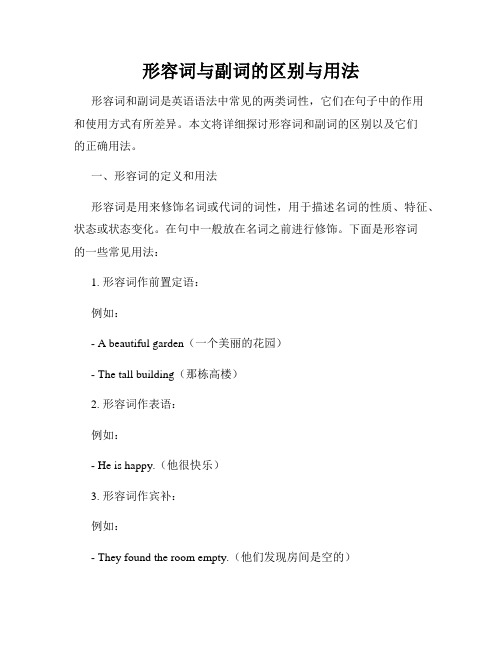
形容词与副词的区别与用法形容词和副词是英语语法中常见的两类词性,它们在句子中的作用和使用方式有所差异。
本文将详细探讨形容词和副词的区别以及它们的正确用法。
一、形容词的定义和用法形容词是用来修饰名词或代词的词性,用于描述名词的性质、特征、状态或状态变化。
在句中一般放在名词之前进行修饰。
下面是形容词的一些常见用法:1. 形容词作前置定语:例如:- A beautiful garden(一个美丽的花园)- The tall building(那栋高楼)2. 形容词作表语:例如:- He is happy.(他很快乐)3. 形容词作宾补:例如:- They found the room empty.(他们发现房间是空的)4. 形容词作定语补足语:例如:- I am sure she is right.(我相信她是对的)二、副词的定义和用法副词是修饰动词、形容词、其他副词、句子或句子成分的词性。
副词可以表示时间、地点、方式、程度、原因等各种概念。
下面是副词的一些常见用法:1. 副词修饰动词:例如:- He runs quickly.(他跑得很快)- She speaks fluently.(她讲得很流利)2. 副词修饰形容词或其他副词:例如:- The house is very beautiful.(房子非常漂亮)- He speaks quite softly.(他说话非常轻声细语)3. 副词修饰句子或句子成分:例如:- Unfortunately, I can't attend the meeting.(不幸的是,我不能参加会议)- She arrived late.(她到达得很晚)三、形容词和副词的比较尽管形容词和副词有一些相似之处,但它们在用法上有一些明显的区别。
1. 修饰词性不同:形容词修饰名词,描述名词的性质或状态;副词修饰动词、形容词或其他副词,表示时间、地点、方式、程度等。
2. 位置不同:形容词一般放在名词前面,修饰名词;副词一般放在动词、形容词或其他副词之后,修饰它们。
形容词与副词的用法区别与辨析
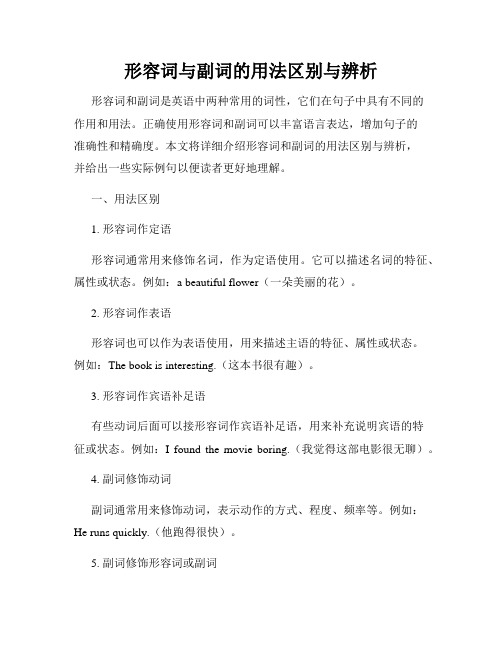
形容词与副词的用法区别与辨析形容词和副词是英语中两种常用的词性,它们在句子中具有不同的作用和用法。
正确使用形容词和副词可以丰富语言表达,增加句子的准确性和精确度。
本文将详细介绍形容词和副词的用法区别与辨析,并给出一些实际例句以便读者更好地理解。
一、用法区别1. 形容词作定语形容词通常用来修饰名词,作为定语使用。
它可以描述名词的特征、属性或状态。
例如:a beautiful flower(一朵美丽的花)。
2. 形容词作表语形容词也可以作为表语使用,用来描述主语的特征、属性或状态。
例如:The book is interesting.(这本书很有趣)。
3. 形容词作宾语补足语有些动词后面可以接形容词作宾语补足语,用来补充说明宾语的特征或状态。
例如:I found the movie boring.(我觉得这部电影很无聊)。
4. 副词修饰动词副词通常用来修饰动词,表示动作的方式、程度、频率等。
例如:He runs quickly.(他跑得很快)。
5. 副词修饰形容词或副词副词也可以用来修饰形容词或副词,表示程度或程度的比较。
例如:She is very beautiful.(她非常漂亮)。
6. 副词作状语副词可以作状语,修饰整个句子或者句子中的某一部分,表示时间、地点、方式、原因、目的等。
例如:He speaks English fluently.(他英语说得很流利)。
二、用法辨析1. 形容词和副词的形式不同形容词和副词的形式有所不同,在大多数情况下,形容词以-y结尾的单词变为副词时,将-y改为-i再加-ly。
例如:happy(形容词)→ happily(副词)。
2. 形容词描述名词,副词描述动词形容词通常用来描述名词,表示名词的性质、状态等;而副词主要用于修饰动词,表示动作的方式、程度、频率等。
3. 形容词有属格和比较级形式,副词没有形容词可以使用属格形式和比较级形式,用来表示所有关系和比较程度。
例如:John's house(约翰的房子)、more beautiful(更美丽)。
形容词与副词的区别与变化规则
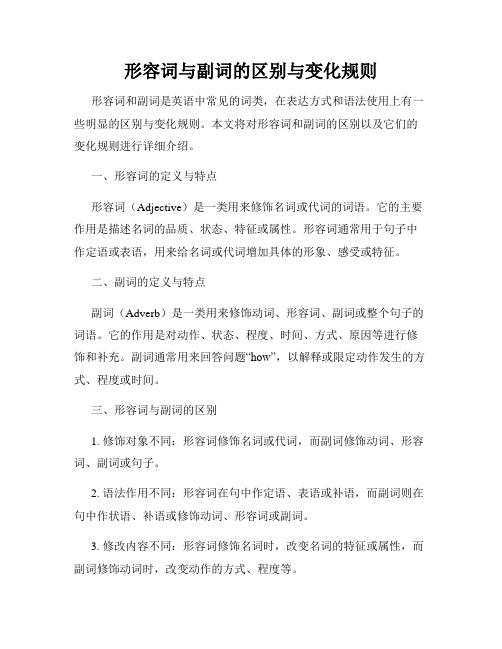
形容词与副词的区别与变化规则形容词和副词是英语中常见的词类,在表达方式和语法使用上有一些明显的区别与变化规则。
本文将对形容词和副词的区别以及它们的变化规则进行详细介绍。
一、形容词的定义与特点形容词(Adjective)是一类用来修饰名词或代词的词语。
它的主要作用是描述名词的品质、状态、特征或属性。
形容词通常用于句子中作定语或表语,用来给名词或代词增加具体的形象、感受或特征。
二、副词的定义与特点副词(Adverb)是一类用来修饰动词、形容词、副词或整个句子的词语。
它的作用是对动作、状态、程度、时间、方式、原因等进行修饰和补充。
副词通常用来回答问题“how”,以解释或限定动作发生的方式、程度或时间。
三、形容词与副词的区别1. 修饰对象不同:形容词修饰名词或代词,而副词修饰动词、形容词、副词或句子。
2. 语法作用不同:形容词在句中作定语、表语或补语,而副词则在句中作状语、补语或修饰动词、形容词或副词。
3. 修改内容不同:形容词修饰名词时,改变名词的特征或属性,而副词修饰动词时,改变动作的方式、程度等。
四、形容词的变化规则1. 基本形式:形容词的基本形式一般是原级(原形),如“big”。
2. 比较级(比较形式):形容词在比较级中加“-er”,如“bigger”。
在一些特殊情况下,形容词的比较级会发生规则变化,如“good”变为“better”、“bad”变为“worse”等。
3. 最高级(最高形式):形容词在最高级中加“-est”,如“biggest”。
同样地,一些形容词在最高级中会有规则变化,如“best”、“worst”。
五、副词的变化规则1. 基本形式:大多数副词的基本形式与形容词相同,只是作用不同,如“loud”(形容词)和“loudly”(副词)。
2. 比较级和最高级:大多数副词的比较级和最高级都是在前面加“more”和“most”,如“more slowly”、“most beautifully”。
语法专题讲解形容词和副词的用法
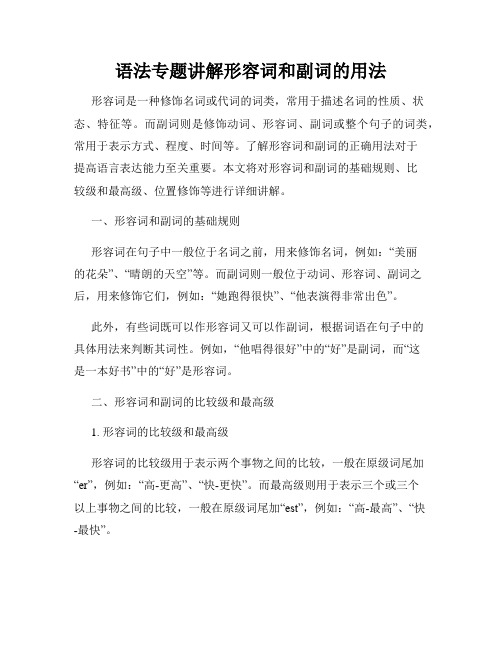
语法专题讲解形容词和副词的用法形容词是一种修饰名词或代词的词类,常用于描述名词的性质、状态、特征等。
而副词则是修饰动词、形容词、副词或整个句子的词类,常用于表示方式、程度、时间等。
了解形容词和副词的正确用法对于提高语言表达能力至关重要。
本文将对形容词和副词的基础规则、比较级和最高级、位置修饰等进行详细讲解。
一、形容词和副词的基础规则形容词在句子中一般位于名词之前,用来修饰名词,例如:“美丽的花朵”、“晴朗的天空”等。
而副词则一般位于动词、形容词、副词之后,用来修饰它们,例如:“她跑得很快”、“他表演得非常出色”。
此外,有些词既可以作形容词又可以作副词,根据词语在句子中的具体用法来判断其词性。
例如,“他唱得很好”中的“好”是副词,而“这是一本好书”中的“好”是形容词。
二、形容词和副词的比较级和最高级1. 形容词的比较级和最高级形容词的比较级用于表示两个事物之间的比较,一般在原级词尾加“er”,例如:“高-更高”、“快-更快”。
而最高级则用于表示三个或三个以上事物之间的比较,一般在原级词尾加“est”,例如:“高-最高”、“快-最快”。
如果原级词以“e”结尾,则只需在词尾加上“r”或“st”,例如:“large- larger- largest”。
而对于以一个辅音字母结尾的重读闭音节词,则要双写辅音字母,并加上“er”或“est”,例如:“big- bigger- biggest”。
2. 副词的比较级和最高级副词的比较级和最高级的构成与形容词的变化规则相似,一般在原级词尾加“er”或“est”,例如:“quickly- quicker- quickest”。
然而,有一些词的比较级和最高级是不规则的,例如:“well- better- best”、“badly- worse- worst”。
需要特别注意的是,有些词没有比较级或最高级,只能用原级形式表达。
例如,“unique”、“perfect”等词。
英语形容词_副词讲解

1. 某些形容词加上定冠词可以泛指一类人,与谓语动词 的复数连接。如:the dead,the living,the rich, the poor,the blind,the hungry (The poor are losing hope. ) 2. 有关国家和民族的形容词加上定冠词指这个民族的整 体,与动词的复数连用。例如:the British,the English,the French,the Chinese. (The English have wonderful sense of humor. ) 多个形容词修饰名 词的顺序 多个形容词修饰名词时,其顺序为: 限定词--数词--描绘词--(大小,长短,形状,新旧,颜色) --出处--材料性质,类别--名词 例如: a small round table a tall gray building a dirty old brown shirt a famous German medical school an expensive Japanese sports car
9. 表示主语长期的静止状态,不强调动作的sit,stand,lie 接形容词quiet, silent, still, red, peaceful等 The valley lay quiet and peaceful She sat silent. They stood still. 10. become,fall ,get,go,turn表示变得时后跟形容词. The leaves fell/got/went/turned yellow. It fell/got/went/turned cold. 11. present表示出席的,到场的的时候常放在名词后,the members present表示现在的则放在名词前the present members 12. live有时可用做形容词: a live fish 活鱼(形容动物, 不形容人 ) The broadcast comes to you live from Canada 实况转播 That wire is live 电线是带电的 lively 生动的,活泼的。His class is often lively. 13. the +adj表示一类人,是复数The rich should help the poor. the blind/wounded/young/old
形容词和副词的区别与用法
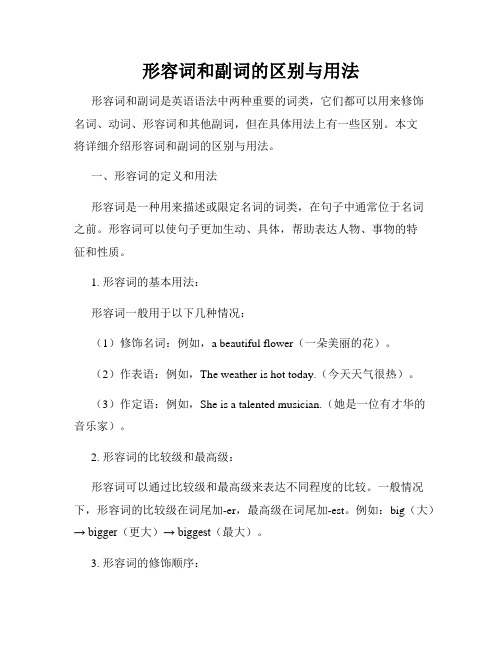
形容词和副词的区别与用法形容词和副词是英语语法中两种重要的词类,它们都可以用来修饰名词、动词、形容词和其他副词,但在具体用法上有一些区别。
本文将详细介绍形容词和副词的区别与用法。
一、形容词的定义和用法形容词是一种用来描述或限定名词的词类,在句子中通常位于名词之前。
形容词可以使句子更加生动、具体,帮助表达人物、事物的特征和性质。
1. 形容词的基本用法:形容词一般用于以下几种情况:(1)修饰名词:例如,a beautiful flower(一朵美丽的花)。
(2)作表语:例如,The weather is hot today.(今天天气很热)。
(3)作定语:例如,She is a talented musician.(她是一位有才华的音乐家)。
2. 形容词的比较级和最高级:形容词可以通过比较级和最高级来表达不同程度的比较。
一般情况下,形容词的比较级在词尾加-er,最高级在词尾加-est。
例如:big(大)→ bigger(更大)→ biggest(最大)。
3. 形容词的修饰顺序:多个形容词修饰同一个名词时,它们的顺序是有规律的。
通常,形容词的顺序是:冠词、观点或态度、大小、形状、年龄、颜色、国籍或来源、材料或用途、类别等。
例如:a beautiful small round glass bowl (一只漂亮的小圆玻璃碗)。
二、副词的定义和用法副词是一种用来修饰动词、形容词、其他副词和整个句子的词类,用来表达时间、地点、方式、程度等概念。
1. 副词的基本用法:副词可以用于以下几种情况:(1)修饰动词:例如,She sings beautifully.(她唱得很好听)。
(2)修饰形容词:例如,The movie is extremely interesting.(这部电影非常有趣)。
(3)修饰其他副词:例如,He speaks very slowly.(他说话非常慢)。
2. 副词的比较级和最高级:和形容词类似,副词也可以通过比较级和最高级来表达不同程度的比较。
形容词和副词的知识点归纳
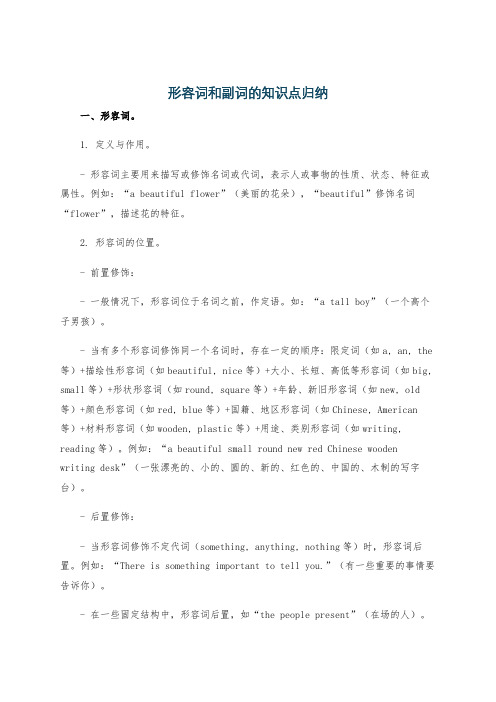
形容词和副词的知识点归纳一、形容词。
1. 定义与作用。
- 形容词主要用来描写或修饰名词或代词,表示人或事物的性质、状态、特征或属性。
例如:“a beautiful flower”(美丽的花朵),“beautiful”修饰名词“flower”,描述花的特征。
2. 形容词的位置。
- 前置修饰:- 一般情况下,形容词位于名词之前,作定语。
如:“a tall boy”(一个高个子男孩)。
- 当有多个形容词修饰同一个名词时,存在一定的顺序:限定词(如a, an, the 等)+描绘性形容词(如beautiful, nice等)+大小、长短、高低等形容词(如big, small等)+形状形容词(如round, square等)+年龄、新旧形容词(如new, old 等)+颜色形容词(如red, blue等)+国籍、地区形容词(如Chinese, American 等)+材料形容词(如wooden, plastic等)+用途、类别形容词(如writing, reading等)。
例如:“a beautiful small round new red Chinese woodenwriting desk”(一张漂亮的、小的、圆的、新的、红色的、中国的、木制的写字台)。
- 后置修饰:- 当形容词修饰不定代词(something, anything, nothing等)时,形容词后置。
例如:“There is something important to tell you.”(有一些重要的事情要告诉你)。
- 在一些固定结构中,形容词后置,如“the people present”(在场的人)。
3. 形容词的比较级和最高级。
- 规则变化:- 一般在词尾加 -er(比较级)和 -est(最高级)。
如:tall - taller - tallest。
- 以不发音的e结尾的单词,加 -r和 -st。
如:nice - nicer - nicest。
形容词和副词的用法区别
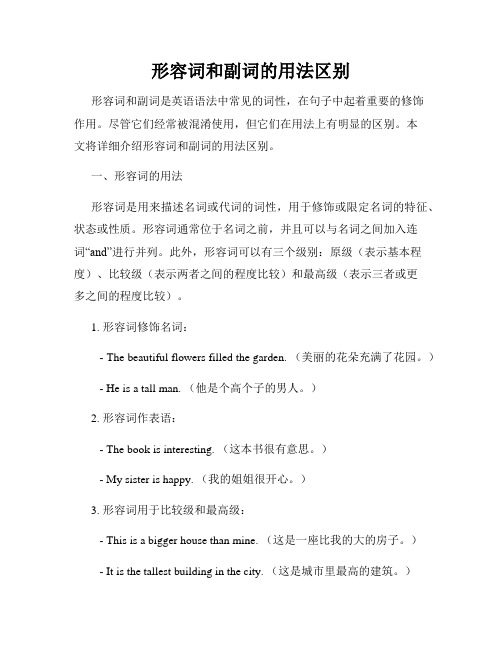
形容词和副词的用法区别形容词和副词是英语语法中常见的词性,在句子中起着重要的修饰作用。
尽管它们经常被混淆使用,但它们在用法上有明显的区别。
本文将详细介绍形容词和副词的用法区别。
一、形容词的用法形容词是用来描述名词或代词的词性,用于修饰或限定名词的特征、状态或性质。
形容词通常位于名词之前,并且可以与名词之间加入连词“and”进行并列。
此外,形容词可以有三个级别:原级(表示基本程度)、比较级(表示两者之间的程度比较)和最高级(表示三者或更多之间的程度比较)。
1. 形容词修饰名词:- The beautiful flowers filled the garden. (美丽的花朵充满了花园。
) - He is a tall man. (他是个高个子的男人。
)2. 形容词作表语:- The book is interesting. (这本书很有意思。
)- My sister is happy. (我的姐姐很开心。
)3. 形容词用于比较级和最高级:- This is a bigger house than mine. (这是一座比我的大的房子。
) - It is the tallest building in the city. (这是城市里最高的建筑。
)二、副词的用法副词是一种修饰动词、形容词、其他副词或整个句子的词性。
它可以用来表示方式、程度、时间、地点和频率等信息。
副词通常位于动词之前,但是在句子中的位置可以灵活调整。
1. 副词修饰动词:- She sings beautifully. (她唱得很美。
)- He drove carefully. (他小心地开车。
)2. 副词修饰形容词:- My sister is very beautiful. (我的姐姐非常漂亮。
)- The food is extremely delicious. (这食物太美味了。
)3. 副词修饰其他副词:- He speaks English quite fluently. (他英语说得相当流利。
- 1、下载文档前请自行甄别文档内容的完整性,平台不提供额外的编辑、内容补充、找答案等附加服务。
- 2、"仅部分预览"的文档,不可在线预览部分如存在完整性等问题,可反馈申请退款(可完整预览的文档不适用该条件!)。
- 3、如文档侵犯您的权益,请联系客服反馈,我们会尽快为您处理(人工客服工作时间:9:00-18:30)。
形容词和副词(一)形容词1、形容词及其用法形容词修饰名词,说明事物或人的性质或特征。
通常,可将形容词分成性质形容词和叙述形容词两类,其位置不一定都放在名词前面。
1)直接说明事物的性质或特征的形容词是性质形容词,它有级的变化,可以用程度副词修饰,在句中可作定语、表语和补语。
例如:hot 热的。
2)叙述形容词只能作表语,所以又称为表语形容词。
这类形容词没有级的变化,也不可用程度副词修饰。
大多数以 a 开头的形容词都属于这一类。
例如:afraid 害怕的。
错)He is an ill man.对)The man is ill.错)She is an afraidgirl对)The girl isafraid.这类词还有:well ,unwell ,ill ,faint ,afraid,alike ,alive ,alone,asleep,awake 等。
3)形容词作定语修饰名词时,要放在名词的前边。
但是如果形容词修饰以-thing 为字尾的词语时,要放在这些词之后,(形容词修饰不定代词要后置)例如:something nice somewhere warm2. 以-ly 结尾的形容词1)大部分形容词加-ly 可构成副词。
但friendly ,deadly,lovely ,lonely ,likely ,lively ,ugly,brotherly ,仍为形容词。
改错:(错)She sang lovely.(错)He spoke to me very friendly.(对)Her singing was lovely.(对)He spoke to me in a very friendly way.2)有些以-ly 结尾既为形容词,也为副词。
daily ,weekly ,monthly ,yearly ,earlyThe Times is a daily paper.The Times is published daily.3用形容词表示类别和整体1)某些形容词加上定冠词可以泛指一类人,与谓语动词的复数连接。
如:the dead, theliving ,the rich ,the poor,the blind ,the hungryThe poor are losing hope.2)有关国家和民族的形容词加上定冠词指这个民族的整体,与动词的复数连用。
the British , the English , the French, the Chinese.The English have wonderful sense of humor.4多个形容词修饰名词的顺序多个形容词修饰名词时,其顺序为:限定词--数词--描绘词--(大小,长短,形状,新旧,颜色) --出处--材料性质,类别--名词a small round table a tall gray buildinga dirty old brown shirta famous German medical schoolan expensive Japanese sports car 典型例题 :1)Tony is going camping with ___ boys. A. little two other B. two little other答案:C 。
由"限定词--数词--描绘词--(大小,长短,形状,新旧,颜色 公式可知数词,描绘词,性质依次顺序,只有 C 符合答案。
2) One day they crossed the ___ bridge behind the palace.A. old Chinese stoneB. Chinese old stoneC. old stone Chinese old答案 A. 几个形容词修饰一个名词,他们的排列顺序是:年龄,形状,大小 质地 +用途 +国家 + 名词。
3) - How was your recent visit to Qingdao?- It was great. We visited some friends , and spent the ___days at the seaside. A. few last sunnyB. last few sunnyC. last sunny fewD. few sunny last答案:B 。
本题考查多个形容词的排序问题。
一般与被修饰形容词关系密切的形容词靠近名 词;如果几个形容词的重要性差不多,音节少的形容词在前, 音节多的方在后,在不能确定 时,可参照下表:限定词 +数量词(序数词在前,基数词在后)+性状形容词 +大小、长短、高低等形体 +those + three + beautiful + large + square 新旧 +颜色 +国籍 +材料 +名词 old + brown + wood +table5 下列几类形容词也没有比较等级:(1) 表示“终极” 意义或绝对概念的形容词或副词。
如: absolute(ly), blind, dead, excellent,entire, living, full, perfect(ly), round, relative, wrong 等。
(2) 表示时间、方位或方向的形容词或副词。
如: back, backward, forward, front, past,monthly, weekly, present, southern, vertical 等。
(3) 部分表示事物性质、物质材料或结构成分的形容词。
如:atomic, cultural, economic,educational, golden, political, scientific, silken, urban, wooden 等。
(4) 本身具有“最”或“唯一”概念的形容词。
如: maximal, mere, minimal, matchless, sole, only unique 等。
6 形容词作定语时的后置a •前面我们讲到形容词作定语时,位置要放在所修饰的名词前面,但当它带有表示量度的词 或词组时,定语后置。
They have built a bridge a hundred meters long. 他们建成了一座一百米长的桥。
Last year we built a building thirteen storeys high. 去年,我们盖了一栋十三层的高楼。
b •带有表示量度的词或词组,作表语时,也后置。
The bridge is a hundred meters long. 这座桥长达一百米。
The building is thirteen storeys high. 这个大楼有十三层高。
They have built a two-hundred-meter-long bridge. 他们已经修建了一座长二百米的桥。
量度词组变成合成语时,作定语用,放在名词前。
Last year we built a thirteen-storey-high building. 去年我们建了一座高十三层的大楼。
C •另外,一些形容词或形容词词组常用来放在句首、句中或句尾,作状语。
He returned home, tired and hungry.他又累又饿地回到了家。
Cold and hungry, he walked in the street. 又冷又饿,他走在街道上。
(二) 副词及其基本用法C. two other littleD. little other two) --性质 --名词 "的 D. Chinese stone+ 颜色 +来源 +1、副词的种类、用法和位置副词在句子中修饰动词、形容词、副词或整个句子。
用来表示时间、场所、状态及程度。
.副词的种类(1)时间副词①表示大体时间:now,then,yesterday,today, tonight,before,just now,reCently,so far②表示频率:always,usually,often,sometimes.seldom,never③其它作用:already,yet,late,early,soon,at onCe,immediately,at first,at last,finally(2)地点副词①表地点:here,there,home,abroad,upstairs,downstairs,anywhere,everywhere,nowhere,somewhere.②表位置关系(后接宾语时,用作介词):above,below,round,around,down,up,in,out,inside,outside,aCross,baCk,along,over,away,near,off,past(3)方式副词表示谓语动词"怎样地",(此类副词大部分由形容词加ly 构成):badly,bravely,gratefully,Calmly,Carefully,Carelessly,nervously,proudly,patiently,politely,sadly,properly,rapidly,wrongly,suddenly.(4)程度副词多数用来修饰形容词或副词:muCh,(a)little,abit,very,so,too,enough,quite,rather,Completely,terribly,deeply,nearly,almost,hardly (5)疑问副词构成特殊疑问句:how,when, where,why(6)连接副词连接主语、宾语或表语从句:how,when,where,why(7)关系副词引导定语从句:when,where,why(8)其它性质的副词对整个句子进行说明,一般用逗号与主句隔开:fran kly (坦率地说,说真的),gen erally (一般说来),luckily (幸运地是),first of all (首先)等。
2.地点副词、时间副词和方式副词一般放在句末地点副词作定语时要后置,不属于这种情况。
有时少数地点副词和时间副词可以作定语,放在所修饰词的后边。
The students here are all from China.I'll wait for you here. (地点副词)我将在这儿等你。
I'll meet him at the station tomorrow. (时间副词)明天我将去车站接他。
Tomorrow I'll meet him at the station.、I • 注意有时为了强调时间,也可把时间副词放在句首。
